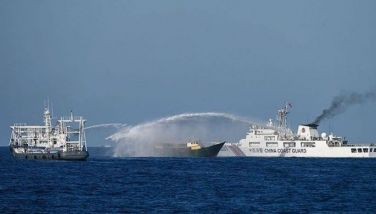#Journeyto30 Earthquake!
MANILA, Philippines - It was normal school day at the Christian College of the Philippines in Cabanatuan City, Nueva Ecija. It was just a few minutes past 4 p.m. and students were eager to finish the last subject of the day and go home.
Over in Baguio City, at the Hyatt Terraces Hotel, the day was just beginning, especially as hotel guests and patrons were filling the casino to place bets on the several games of chance being played.
In Dagupan City, Pangasinan, moviegoers at the popular Jade Theater munched on popcorn while enjoying the film that was showing.
All over Metro Manila, people went about their ordinary lives. Crane operators at the Manila’s Port Area did their daily task of hoisting and stacking container vans brought in and out by various ships. White-collared professionals walked the stretch of Ayala Avenue in Makati.
However, at 4:26 p.m., what seemed like an ordinary day turned into something out of the ordinary. Suddenly, the ground shook violently for 45 seconds, causing buildings to topple, bridges to collapse and roads to crack open and release mud.
The patrons at the Jade Theater dropped their sodas, popcorn and other belongings and dashed to main exit, causing a stampede.
While this was happening, the whole Liwag Building of the Christian College of the Philippines collapsed with students, teachers and school staff inside.
The foundations of the Hyatt Terraces Hotel also buckled at the strength of the quake, causing it to topple, trapping guests and staff. Many of the guests who were playing at the casino were either dead or trapped.
Crane operators at the Manila port were caught off guard by the shaking. Operations were quickly suspended as container vans fell on each other and on parked cars.
In Makati City, office workers calmly rushed out of their buildings and into the streets. The eighth and nine floors of the Rufino Building along Ayala Avenue gave in to the temblor. Also damaged were the Cojuangco, Locsin, Ayala and T. Alonzo buildings.
The country’s response was quick. Then President Corazon Aquino quickly activated all regional disaster councils and mobilized all available emergency response units, including the police, armed forces and the coast guard. She convened the National Disaster Coordinating Council to monitor the progress of the disaster response efforts. Members of the Cabinet were tasked to different provinces to supervise these efforts.
Among the first areas that rescuers and journalists quickly reached was Cabanatuan City. Local and international press coverage of the disaster immediately focused on the collapsed Liwag Building of the Christian College of the Philippines, where at least 30 students died and 150 were trapped.
Elsewhere in Nueva Ecija, other buildings fell as well. The library of the Central Luzon State University in Muñoz collapsed and killed 75 people. In San Jose City, three more buildings collapsed, killing at least nine people.
In neighboring Pangasinan, 13 people died in the stampede of moviegoers inside the Jade Theater in Dagupan City. The city’s public market and the Magsaysay Commercial Center also fell during the tremor. Two bridges in the province also fell.
But while disaster response was fast throughout much of Central Luzon, Baguio City was trapped from the rest of island. Landslides blocked the major roads leading to the mountain resort city, including Naguilian Road, Kennon Road and Marcos Highway. Volunteers and rescuers going the city had to be flown by helicopter or had to walk the portions of the roads that were still passable. It took three days before these roads were cleared of blockages.
The city was devastated, with many buildings either fully destroyed or damaged. Aside from the Hyatt Terraces Hotel, the Nevada Hotel, Baguio Hilltop Hotel, Baguio Park Hotel and FRB Hotel were also destroyed. The city’s Burnham Park turned from tourist attraction to tent city overnight.
Because the city was cut off from the rest of Luzon, food, water and medicine quickly ran out. The people of Baguio had to rely on bayanihan to rescue people trapped under the rubble and tend to survivors.
As more people emerged from heaps of debris, record-breaking stories of survival were told to the press. Among them were part-time cook Luisa Mallorca and gym instructor Arnel Calabia, who survived under the rubble of the Hyatt Terraces Hotel for 11 days by drinking their own urine. Pedrito Dy, the 27-year-old baker of the same hotel, broke this record after he was recovered alive three days later.
But aside from stories of survival, journalists also recorded stories of heroism.
Among them was the gallantry of 20-year-old high school student Robin Garcia, who survived the initial temblor but went back to the collapsed building to save eight more trapped underneath. In his fourth rescue try, an aftershock rocked the site, killing Garcia.
A handful of those who survived the killer quake are forever indebted to Garcia’s heroism. He was posthumously awarded the Boy Scouts of the Philippines’ Medal of Honor while President Aquino conferred upon him the Grieving Heart Medal.
With a surface wave magnitude of 7.8 and estimated damage worth P15 billion, the 1990 Luzon Earthquake was the strongest and costliest to hit the island in 20 years. With a death toll of at least 1,600 and thousands more injured or missing, it was captured in our collective consciousness as a “killer quake.”
While earthquakes of such magnitude are a rarity in the Philippines, it will definitely happen again, perhaps even at a stronger magnitude. Only time will tell when the next “big one” will strike.
Consequently, the catastrophe also taught us to be better prepared for future disasters, with fire and earthquake drills now being held regularly in different companies and on a metro-wide scale during the recent MMDA Metrowide Shake Drill. New skyscrapers and buildings are now being built following earthquake-resistant standards. And telecommunication companies are now issuing SMS alerts during natural disasters.
But many still remain vulnerable to such catastrophes, particularly the poor who live in flimsy shelters. We need to do more to ensure that our preparedness for upcoming disasters is inclusive of the most vulnerable sectors of our society.
- Latest
- Trending



























